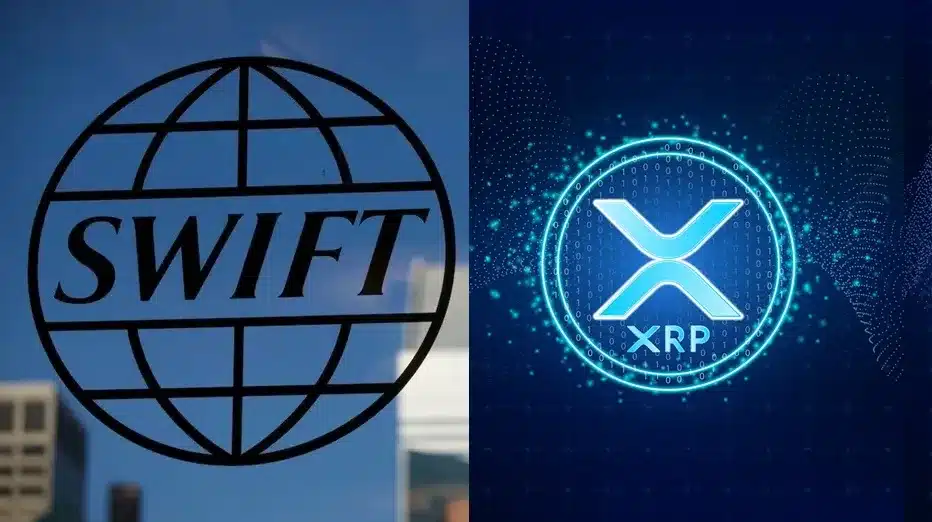For more than four decades, the SWIFT network has functioned as the backbone of international financial communication, linking over 11,000 banks across 200+ countries.
But as financial institutions face growing pressure to modernize cross-border payments, XRP, a digital asset purpose-built for real-time value transfer, is emerging as a serious contender to disrupt the legacy infrastructure.
While SWIFT (Society for Worldwide Interbank Financial Telecommunication) has improved its average settlement time to 24 hours as of last year, that still pales in comparison to what modern blockchain-based protocols can achieve.
Enter XRP, whose transactions settle in three to five seconds, at a fraction of a cent in fees. And now, according to recent developments and pilot programs, XRP is no longer just an investment vehicle; it’s becoming a potential operational reserve asset for financial institutions.
XRP vs. SWIFT: A Technology Shift Banks Can’t Ignore
When banks use SWIFT, they’re not just exchanging messages, they’re managing capital burdens. Each transaction often requires intermediary banks, comes with foreign exchange fees, and takes days to finalize. During this period, liquidity is trapped in the system, unable to earn yield or be redeployed efficiently.
Also Read: Ripple CLO Reveals Interesting Details About Crypto Ownership in the U.S.
With XRP and the XRP Ledger (XRPL), the need for correspondent banking relationships diminishes. There are no intermediaries, no FX markups, and transactions are finalized almost instantly. For institutions handling millions in daily cross-border volume, this represents a transformative economic advantage.
Recent reports estimate that a single international wire transfer through SWIFT can cost between $25 to $50 in flat fees, not including the FX margin, typically around 1% of the transaction value. In contrast, XRP transfers cost less than $0.01, regardless of the size.
This isn’t just cost reduction, it’s capital liberation.
Predictable Costs, Regulatory Tools, and On-Chain Controls
A frequent barrier to blockchain adoption in traditional finance is compliance. Banks require transparency, oversight, and the ability to enforce Know Your Customer (KYC) and Anti-Money Laundering (AML) standards.
XRPL addresses these concerns with built-in compliance features. Unlike smart contract platforms that require custom code to implement controls, XRPL allows issuers to:
- Freeze individual or global trust lines
- Require deposit authorization
- Control asset flows without external dependencies
This makes XRP not only fast and cheap but institutionally friendly, a rare combination in the crypto space.
Institutional Interest Is Growing Quietly But Steadily
XRP’s appeal as a utility reserve rather than just a speculative asset is gaining traction, especially among central banks and fintech regulators.
- The Royal Monetary Authority of Bhutan has been piloting a CBDC project on XRPL to extend financial services to rural areas.
- In the United Arab Emirates, real estate firms are tokenizing property deeds using XRPL, eyeing over $16 billion in potential assets.
- Ripple has also been involved in cross-border remittance corridors in Latin America, the Middle East, and Southeast Asia.
These pilots are being watched not just by retail investors but by banking executives and regulatory bodies assessing the ledger’s suitability for large-scale deployment.
XRP as a Reserve Asset: Why Banks May Hold Rather Than Sell
If institutions adopt XRP for operational purposes, such as paying network fees, moving tokenized assets, or settling wholesale payments, they are less likely to sell once acquired. This could anchor long-term demand and stabilize the asset’s role within financial ecosystems.
The emerging vision positions XRP not just as a bridge currency but as a core holding in the back offices of tomorrow’s digital banks. As Ripple pushes for integrations in tokenized deposits, stablecoin issuance, and CBDC interoperability, the incentive to hold XRP becomes strategic rather than speculative.
In fact, recent interviews with Ripple executives, including CTO David Schwartz, suggest that Ripple aims to make XRP indispensable for any institution dealing with tokenized financial instruments.
Looking Ahead: XRP’s Institutional Trajectory
While price volatility remains a reality, XRP’s long-term value proposition is now increasingly tied to institutional adoption, infrastructure reliability, and regulatory clarity, not hype cycles or social media speculation.
As financial institutions re-evaluate the utility of legacy systems, XRP stands out as a tested alternative with:
- Proven speed and cost-efficiency
- Built-in compliance architecture
- Ongoing support from a well-funded enterprise (Ripple)
- An expanding list of global pilot programs and real-world applications
And most importantly, XRP is already ISO 20022 compliant, making it fit for integration into the upcoming overhaul of global financial messaging standards.
Final Thought
XRP is not yet replacing SWIFT, but the signs are increasingly hard to ignore. What was once dismissed as another altcoin may be maturing into a critical layer of infrastructure for tomorrow’s financial world.
Disclaimer:
While XRP is gaining traction through various pilots and regulatory conversations, no official confirmation exists that major banks are replacing SWIFT with XRP as of yet.
This article is based on current trends, public data, and industry analysis. Readers are encouraged to follow developments from Ripple, central banks, and global regulators for verified updates.
Also Read: Do Not Sell Your XRP Now, Pundit Advises Holders – Here’s Why
